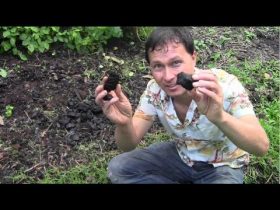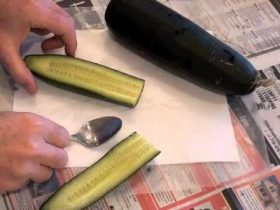If you don’t know what biochar is or aren’t sure about how it can benefit your plants Well, then stick around as I discuss how to use biochar in your garden. I’ve been using it for over 10 years and I’ve actually worked with two different biochar companies to do field trials.
And in all cases It’s made my plants grow better and improved my soil. But it’s very misunderstood and often unknown by many gardeners. Let’s begin by discussing just exactly what biochar is. It’s a type of black carbon and this is where some of the confusion arises because there are many other types of black carbon.
Charcoal is probably the one that we’re most familiar with so many people think charcoal is the same as biochar. And scientifically speaking, there’s a lot of similarities, but for purposes of gardening biochar is a specific type of black carbon that is used specifically to sequester carbon and improve the soil.
Here’s a piece of charcoal that I made using a process that you can often find on YouTube. And here’s a piece of biochar that I received from a biochar producer. They look virtually identical on the outside I made this charcoal using a process where I burn the wood and then quickly doused the fire and removed all the oxygen, resulting in this black carbon.
Biochar is made with a process called pyrolysis. And during that pyrolysis processing almost all of the volatile gases and water is removed from this piece of biochar. That can’t be said for the charcoal. There’s still a lot of water in here and there’s actually a lot of volatile gases. When the volatile gases escape the biochar during pyrolysis what left behind is essentially a framework of pure carbon.
Here’s a demonstration of that basic concept. Imagine that the charcoal is like a golf ball. There’s a lot of surface area in these dimples. But inside it’s not empty. There’s still moisture content and there’s still all those volatile gases and oils. Now, imagine that the biochar is the same size, but it’s a wiffle ball.
There’s a lot of free space on the inside and a lot of big holes on the outside. Now let’s imagine that this wiffle ball is actually put inside of another wiffle ball and this wiffle ball is put inside of another wiffle ball. And we continue this process until that little piece of biochar has millions and millions of these holes that lead to other holes that lead to other holes.
It’s not hollow. It’s a structure filled with open air spaces. And it’s this structure that is the primary reason why I think biochar is so amazing in the garden. Because each of these little holes can become a repository for beneficial soil bacteria and moisture and nutrients. So think of it like a little apartment complex with thousands upon thousands of apartments and each one is inviting in some bacteria that we would like to live in our soil, along with their furniture, which is the moisture levels that improve soil as well.
And the nutrients… well, they’re in an apartment too, but maybe just down the hall. And so as we mix all this into our soil as an amendment. All of these little pieces of biochar are giving back to the soil amazing benefits You just don’t get that with the use of charcoal. Charcoal can benefit the soil structure in some ways.
But it doesn’t have the amazing benefits of biochar. The term biochar was first used in scientific literature in 1988, but it really wasn’t until 2009 that it really started becoming known and gardeners started using it. That’s about the time period that I partnered with that New Jersey biochar company for some field trials.
At the time it was very difficult to find and it was even harder to find anyone that knew what it was. Now you can order it by the bucket online. And you might even be able to find it in your local nursery. There’s also been a lot of peer-reviewed research to show the benefits of biochar along with some problems that might arise.
So if you want to learn more, there’s a lot of information out there that you can find. My trials and other research have shown that seeds will germinate quicker in biochar soil. The plants will grow faster. They’ll put flowers on earlier. And that means you’ll be able to harvest sooner in biochar soil which can be important for a region like mine that has a relatively short growing season.
But there aren’t any studies to show that the fruit tastes any different. It’s not necessarily better tasting fruit. It just comes from a healthier plant. Not all biochar is equal. Any biomass can be turned into biochar using pyrolysis. But that initial ingredient, that biomass, can be different which will give different attributes to the finished biochar.
My friend Mike is my local source for biochar and he’s innovating the use of bones to make bone char. These are bones that would have been discarded from the cattle industry, but he’s allowing them to be reused as an important soil amendment for gardeners. Biochar is best for a poor soil or a soil that is moderate in nutrients and soil life.
When you get to a really nice, lush, rich soil, biochar really doesn’t offer that many benefits, but if you’re trying to create good soil in your garden biochar is ideal because of all of the bacteria and the moisture and the nutrients that reside within the biochar. But there’s an important factor to be aware of when you use biochar.
When you get your biochar, it’s probably going to be very dry. And that’s where the problem arises. It might be slightly moist, but probably not wet. And I won’t go into all the science about positive and negative charges within the biochar and the soil, but think of this as a sponge. It’s soaking in that moisture and it’s soaking up those nutrients because that’s what it does.
If you put dry biochar into your soil you will be sucking out the moisture and the nutrients from your soil and that’s what my trials showed. I had different beds: the control bed with no biochar added, of course; the bed with compost and biochar; the bed with wet biochar; the bed with dry biochar; and a few other options as well.
The bed that did the worst was the dry biochar. It was worse than just the bare soil that had no amendments in it. So when you get your biochar you have to make it ready for your soil you have to inoculate it. That’s also been called charging it or energizing it. And I’ll show you how I do that.
We’re inoculating the biochar with microbes, all those beneficial organisms that are so great for our soil. And so I begin with my soil. This is my garden soil that’s teeming with life and I’m going to add this to the biochar. It’s all of the bacteria, all of those microorganisms that can already survive in my environment, and I’m just putting it into the biochar to help energize the biochar.
I’m also using compost that comes from my own garden as well. It’s got all those microbes that I know will survive in my environment. I’ll mix this around to incorporate the soil and the compost with the biochar But it’s still dry biochar. All of these microbes need moisture to not only survive, but also thrive.
And so this is really the most important step, is to add the moisture to the mix. Now, there’s an important thing to consider. You can just add regular water and that’s fine, because there should be enough of the microbes within the ingredients to populate the biochar, but if you can use worm tea, you’re also introducing all of the bacteria that’s in those worm castings.
If you like to use compost tea, well then add compost tea to this mix as well and you’re introducing all of those microbes. If you have a fish aquarium and you need to clean it out, well, take that water from your aquarium and put it in here because there are amazing amounts of bacteria in aquarium water.
Whatever it is, you need to completely submerge this mix. I really like to use comfrey tea when I energize my biochar. The comfrey tea not only has the microbes, but it’s loaded with nutrients. That all of this biochar just sucks up You can add molasses or syrup or some sugar based liquid at this point and that will boost the bacterial population, but with the addition of the compost and the garden soil that has some organic matter in it.
.. I haven’t really noticed a difference if I add a sugar product that boosts the population, because once that sugar’s gone, they’re gonna run out of food. They need to focus on what’s in the soil. That’s what I’m trying to introduce. So with it all mixed, I’ll let this sit for about three days, longer is fine, and then I’ll start using it in my garden.
There are a number of ways to incorporate biochar into your soil. My preferred method is to incorporate that biochar as you’re creating your bed, as you’re adding soil. For a raised bed as I’m adding my soil I’ll put a few layers of biochar in. When I get to about six inches from the top, I’ll spread biochar.
Then I’ll add some more soil till I get to about three inches from the top and then I add another layer of biochar. And then I finish with that final layer of soil. That’s important because that three-inch and six-inch layer are exactly where the roots are growing. So as the seedlings or the seeds reach that point with their roots, the soil is already filled with all of those wonderful moisture, nutrient, and bacteria levels.
I also do the same thing with mounded raised beds. As I add organic matter and the soil, I’ll add the layers of biochar to improve the whole thing. If you’ve just discovered biochar and your beds are already in place, it’s not too late. I prefer to do this in the fall, but you could easily do it any other time of year.
On the surface of your bed, add your biochar. It works out to about 2 cups of biochar per every square foot. Most recommendations are for adding between half a pound to one pound of biochar to each square foot. Typically, because you’re going to buy biochar by the pound. After it’s in place, you just work it into the soil down to a depth of about six inches.
If you want to add biochar to existing beds well, each time you add a plant or remove a plant just sprinkle some biochar at the bottom of the hole, and eventually you will have incorporated biochar through much of your bed. Another great way to incorporate biochar into your garden is to add biochar to your compost piles.
As you’re layering the different ingredients, just add some extra layers of biochar. You don’t need to inoculate it ahead of time because the process of composting will introduce all those beneficial microbes to the biochar. And biochar can have a high pH. By putting it in the compost pile you help buffer that pH closer to neutral.
When the compost with the biochar is done, add it to your garden as you normally would. My garden trials showed that that mix of compost and biochar actually caused the plants to grow better than any other combination. In areas of the garden that I plan to mulch heavily with woodchips I’ll put a layer of biochar down on the surface of the soil before I add that thick layer of the woodchips.
And as they break down, They’ll automatically energize the biochar underneath and really help create a wonderful soil. Regardless of what method you use to get that biochar into your soil, you only have to do it once. This is a permanent amendment because it continues to give you those benefits year after year without decomposing, without breaking down.
This has been shown in the famous Terra Preta region of the Amazon basin where hundreds of years ago farmers were creating essentially biochar in their soil to allow them to grow. If you use biochar, you’ll never have to replace it. It’ll be in your soil for as long as you garden. With the biochar in the soil, then the real magic takes place.
It’s not just the individual particles of biochar that lead to the benefits. If you think about that biochar as those apartment complexes, well, imagine that a family resides in each of those apartments and as the family grows, well, those kids are going to move out. Where are those kids going to go? They’re going into the soil.
The biochar is just the point that creates that infusion of bacteria and nutrients into the soil and it always holds that ability. But then it permeates the rest of the soil and those microbes continue to grow improving the entire mass. I’ve focused on the ability of biochar to retain the moisture, and the nutrients, and to increase microbial growth within the soil, but it can do a lot more.
It greatly benefits and improves the soil structure. Those particles of biochar help reduce compaction and improve the oxygen levels within the soil. And other organisms that are crawling through the soil like earthworms, well, when they ingest and then digest the biochar, it retains its structure and it’s moved throughout the rest of the bed.
This really is amazing stuff and something you should consider in your garden. If you have any comments or questions, please let me know. Thankyou.











Leave a Reply